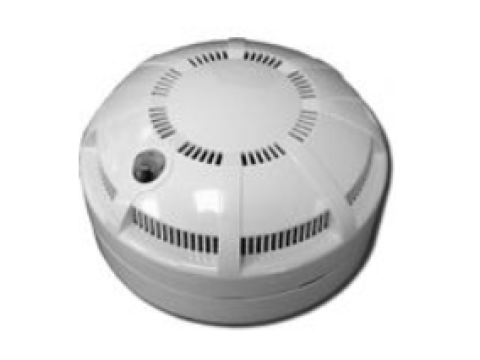A fire alarm detector is a specialized device that quickly identifies early signs of combustion in a protected area. Though often referred to as a “sensor,” these detectors are not simply measuring instruments; rather, they spot fire factors—notably smoke—to help you respond before flames spread. Smoke detectors are the most common, used across private homes, offices, and industrial buildings. Below, we examine how different smoke detectors operate, their key design variants, and the recommended procedures for mounting them to ensure optimal coverage.
How Smoke Fire Detectors Work
All smoke detectors target the presence of aerosol particles generated during the combustion process. Detecting these particles at low concentrations provides early fire warnings, potentially stopping a blaze before it spreads.
Main Types of Smoke Detectors
Optical-Electronic (Photoelectric)
- How it Works: An infrared emitter and a photodiode in a labyrinth. In normal conditions, the IR beam does not reach the diode. When smoke enters, it scatters IR light onto the receiver, generating an alarm signal.
- Usage: Most popular in homes and offices; effective for smoldering fires.
Ionization
- How it Works: A small radioactive source ionizes air between two electrodes. Smoke particles disrupt the ion flow, causing the device to alert.
- Usage: Faster response to flaming fires, but less common due to radioactive components. Typically used in warehouses or seldom-occupied areas.
Aspirating
- How it Works: Air samples are continuously drawn through tubing into a high-sensitivity detection unit.
- Usage: Provides extremely early smoke detection. Suitable for critical areas (e.g., data centers), but expensive and more complex to install.
Point vs. Linear Designs
Point (Spot) Detectors
- Compact devices installed on the ceiling (common in apartments, offices).
- Reliant on smoke reaching the detector location.
Linear (Beam) Detectors
- Transmitter and receiver facing each other—or a single module plus a reflector—spanning large open spaces.
- Trigger an alarm if smoke attenuates the IR beam beyond a preset threshold.
- Commonly used in warehouses, large halls, or areas with high ceilings.
Detector Construction & Signal Transmission
After detecting smoke, the detector must relay a “fire signal” to the fire alarm control panel (or as a local alarm in standalone cases). Different signal methods:
Threshold (Conventional) Detectors
- Basic “alarm/no-alarm” approach based on a fixed threshold of smoke concentration.
- May be non-addressable (no unique ID in the system) or addressable (transmits its “address” so the panel knows which device triggered).
Analog (Real-Time) Detectors
- Continuously measure smoke density, sending data to a control panel for interpretation.
- Generally addressable, enabling the panel to adjust for dust, calibrate automatically, and detect minor changes.
Wireless (Radio-Channel)
- Could be threshold or analog, but rely on radio communication to the panel.
- Battery-powered, typically more expensive, but easier to install where wiring is impractical.
Choosing the Right Smoke Detector
Small Rooms / Private Homes
- Optical point detectors are the simplest, least expensive, and easy to install.
- Typically placed on the ceiling; require minimal wiring or can be a standalone (battery) unit.
Large Warehouses / Admin Buildings
- Linear (Beam) smoke detectors preferred for wide open areas and high ceilings.
- Often used in combination with addressable panels for precise location tracking.
Valuable Assets / Museums / IT Rooms
- Aspirating systems (air-sampling) for ultra-fast detection and highly sensitive coverage.
- More expensive and complex, but crucial for areas with critical property or data.
Ionization Detectors
- Less common nowadays due to radioactive material, used in less-frequented zones or specialized industrial areas.
Installation & Mounting Guidelines
Determining Quantity
- Fire code often suggests at least two detectors per room to ensure redundancy, unless you’re using addressable systems that can isolate individual alarms.
- Large or irregularly shaped spaces may require multiple detectors for full coverage.
Mounting Basics
Point (Spot) Smoke Detectors
- Usually ceiling-mounted.
- Distances from walls or partitions generally set by code (e.g., typically 4–18 inches from any corner).
- Allowed to be placed on walls/columns if ceiling placement is impossible—maintaining similar distance rules.
Beam (Linear) Detectors
- Place transmitter and receiver (or a single block + reflector) so the IR beam crosses the zone near ceiling level.
- Keep the beam at least 4 inches below the ceiling (to avoid thermal layers).
- Ensure no large obstacles (fans, lighting fixtures) interrupt the beam path.
Norms & Regulations
- Codes like NFPA 72 (in the US) or local equivalents define precise distances from walls, corners, overhead beams, and maximum coverage per detector.
- For linear detectors, check that the optical axis is unobstructed, and adhere to maximum recommended range (often 100 meters).
Wiring & Connections
- Wired Models: Typically two- or four-wire circuits connecting to the fire panel.
- Polarity must be observed for addressable/analog.
- Wireless: Each sensor has a built-in radio transmitter and battery. The panel’s wireless receiver must be within effective range.
Final Thoughts
Smoke fire detectors remain the cornerstone of most fire alarm systems due to their early detection capabilities. Whether point (spot-type) or linear (beam), they’re a proven, reliable solution for a wide variety of environments—from small apartments to massive warehouse complexes.
Key Takeaways:
- Optical (Photoelectric) detectors dominate residential and office usage.
- Ionization detectors exist but are less common due to their radioactive component.
- Aspirating (air-sampling) detectors provide super-early detection for critical sites or high-value assets.
- Linear (Beam) sensors handle expansive areas with tall ceilings.
- Installation must follow local codes for spacing, height, and wiring/power considerations.
For further guidance—choosing the appropriate smoke detection technology or ensuring code-compliant setup—visit safsale.com. Our experts can help tailor an optimal fire alarm solution, whether you need basic smoke sensors or advanced aspirating systems for high-risk environments.

